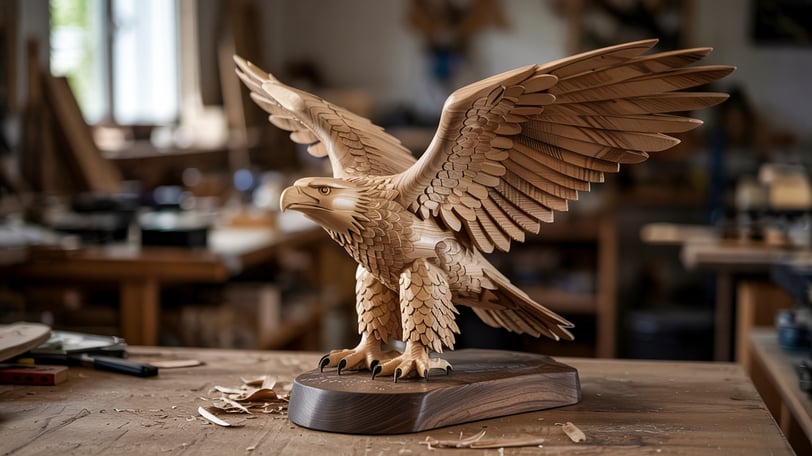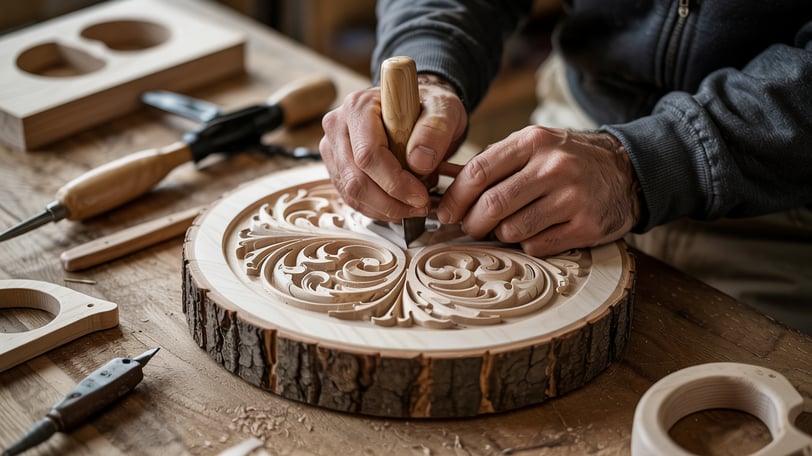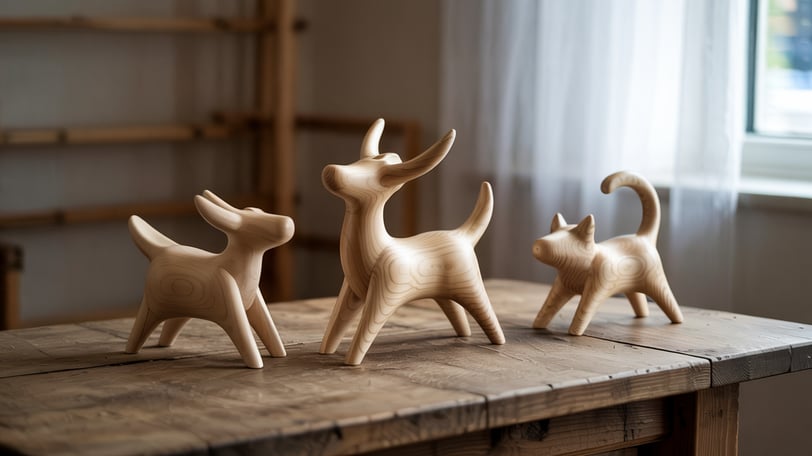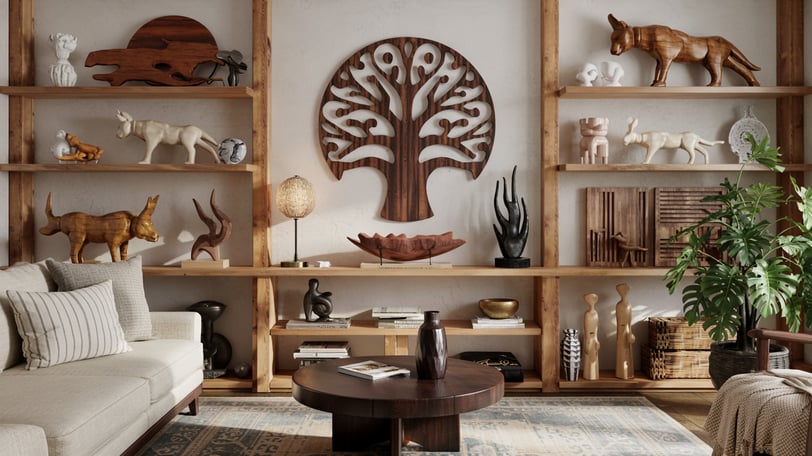The Timeless Beauty of Wood Art: Crafting and Appreciating Wooden Masterpieces
Explore the captivating world of wood art—its history, techniques, and enduring allure. Gain insights into the craftsmanship behind each masterpiece and discover the beauty of this timeless medium.


In the realm of artistic expression, few mediums offer the warmth, versatility, and timeless appeal of wood. From intricate carvings to elegant sculptures, wood art has captivated the imaginations of artists and enthusiasts for centuries. In this blog, we'll delve into the world of wood art, exploring its rich history, diverse techniques, and enduring significance in the realm of creativity and craftsmanship.
Wood Art Through the Ages
Wood art traces its origins back to ancient civilizations, where skilled artisans carved intricate designs into sacred objects and architectural elements. From the ornate temples of Egypt to the intricate wooden sculptures of China, wood was revered for its natural beauty and malleability.
During the Renaissance period, wood art experienced a revival, with master craftsmen such as Michelangelo and Donatello elevating the medium to new heights of sophistication and artistry. Sculptors and woodworkers explored new techniques and styles, creating breathtaking masterpieces that showcased the beauty and versatility of wood.
In the modern era, wood art continues to evolve, with artists pushing the boundaries of traditional techniques and embracing innovative approaches to their craft. From abstract sculptures to functional furniture pieces, wood art remains a vibrant and dynamic form of expression.


The Appeal of Wood Art
One of the enduring appeals of wood art is its natural beauty. Each piece of wood carries its own unique grain, texture, and color, creating a rich tapestry of visual interest. Whether carved, turned, or sculpted, wood art celebrates the inherent beauty of the material, allowing artists to showcase its organic qualities in their work.
Wood art is also prized for its versatility. From delicate carvings to robust furniture pieces, wood can be shaped and manipulated in countless ways, allowing artists to explore a wide range of forms and styles. Whether working with traditional hand tools or modern machinery, woodworkers have the flexibility to bring their creative visions to life in stunning detail.
Beyond its aesthetic appeal, wood art also carries cultural significance. Throughout history, wood has played a central role in religious rituals, artistic traditions, and everyday life. From totem poles to ceremonial masks, wood art has been used to convey stories, beliefs, and cultural identity, serving as a tangible link to the past.


Crafting Wood Art: Techniques and Tools
Creating wood art requires a combination of skill, patience, and craftsmanship. Whether carving intricate details or shaping smooth curves, woodworkers employ a variety of techniques to achieve their desired effects.
Carving is perhaps the most iconic technique in wood art, allowing artists to sculpt three-dimensional forms from a solid block of wood. Using chisels, gouges, and other hand tools, carvers carefully remove material to reveal the desired shape, texture, and detail.
Turning is another popular technique in wood art, particularly for creating round or cylindrical forms such as bowls, vases, and spindles. Using a lathe, woodturners rotate a piece of wood against a cutting tool, allowing them to shape and smooth the surface with precision and control.
Joinery is essential for creating functional wood art pieces such as furniture and cabinetry. By mastering techniques such as dovetailing, mortise and tenon, and tongue and groove, woodworkers can create strong and durable connections that ensure their pieces stand the test of time.


Learning and Growing as a Wood Artist
For aspiring wood artists, there are countless opportunities to learn and grow in their craft. Whether through formal education, hands-on experience, or online resources, there are many paths to mastering the art of woodworking.
Educational resources such as woodworking classes, workshops, and tutorials offer valuable instruction and guidance for wood artists of all skill levels. Whether learning basic techniques or exploring advanced concepts, these resources provide a solid foundation for building proficiency and confidence in woodworking.
Community and collaboration are also essential for wood artists seeking to expand their knowledge and skills. Joining woodworking clubs, attending meetups, and participating in online forums can connect artists with peers, mentors, and potential collaborators, fostering a sense of camaraderie and shared learning.
Exhibiting and selling wood art can provide valuable exposure and recognition for emerging artists. Whether showcasing work at local galleries, craft fairs, or online marketplaces, exhibiting allows artists to share their creations with a wider audience and receive feedback from collectors and enthusiasts.


Collecting and Appreciating Wood Art
For art enthusiasts and collectors, wood art offers a unique opportunity to connect with the natural world and the creative spirit of the artist. Whether acquiring pieces for personal enjoyment or investment, collecting wood art allows individuals to surround themselves with beauty, craftsmanship, and history.
Building a collection of wood art requires careful consideration of personal taste, artistic style, and budget. Whether focusing on a specific artist, genre, or period, collectors can curate a diverse and meaningful collection that reflects their interests and passions.
Displaying wood art in the home allows collectors to enjoy their pieces on a daily basis and share them with family and friends. Whether showcasing sculptures on shelves, hanging wall-mounted pieces, or arranging furniture in living spaces, displaying wood art adds warmth, character, and sophistication to any environment.
Preserving and caring for wood art is essential for maintaining its beauty and integrity over time. Proper storage, handling, and maintenance techniques can help protect pieces from damage caused by moisture, sunlight, and pests. Regular cleaning and polishing can also enhance the natural luster of wood and ensure that it remains vibrant and resilient for generations to come.
In conclusion, wood art stands as a testament to the enduring allure of nature, craftsmanship, and human creativity. From ancient carvings to contemporary sculptures, wood art continues to captivate and inspire audiences around the world. Whether creating, collecting, or simply admiring, the beauty of wood art invites us to connect with the natural world and celebrate the timeless artistry of this remarkable medium.
By exploring the rich history, diverse techniques, and enduring significance of wood art, we gain a deeper appreciation for its beauty, craftsmanship, and cultural importance. Whether as artists, collectors, or enthusiasts, we have the opportunity to embrace the warmth, versatility, and timeless appeal of wood art in all its forms.
Through our exploration of wood art, we celebrate the craftsmanship, creativity, and cultural heritage that define this timeless medium. From its humble origins to its contemporary expressions, wood art continues to inspire, enrich, and delight audiences around the world. As we continue to explore the beauty and complexity of wood art, we deepen our connection to the natural world and the enduring legacy of human creativity.
